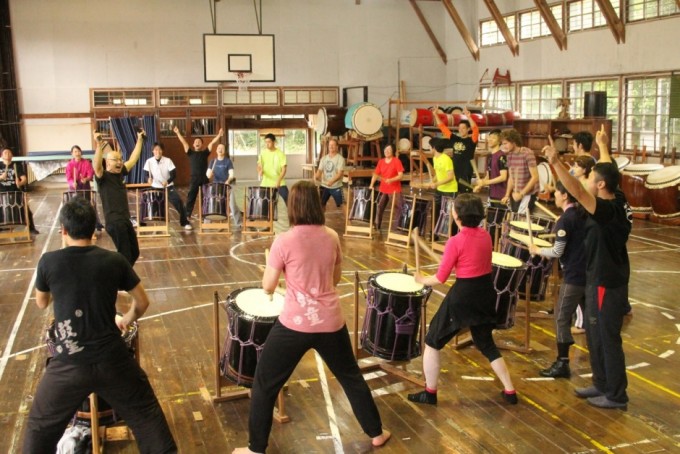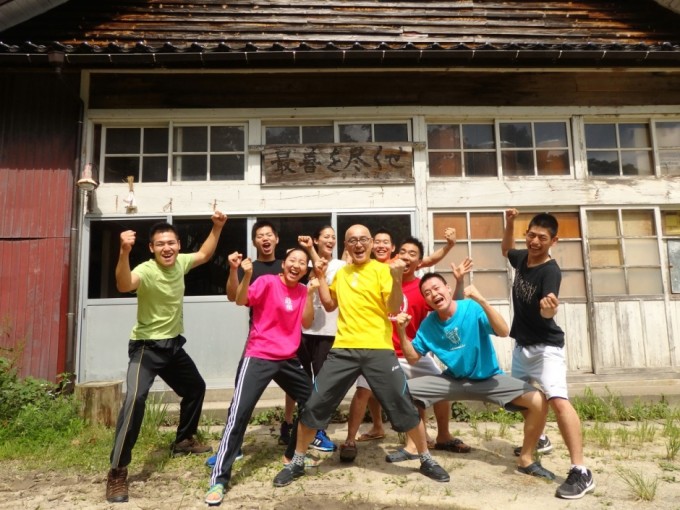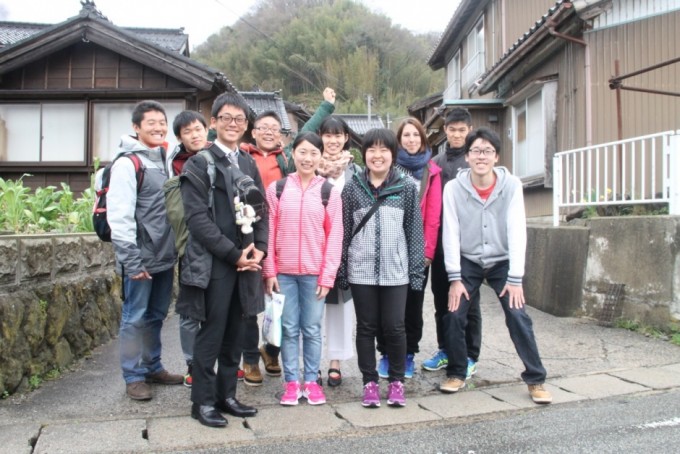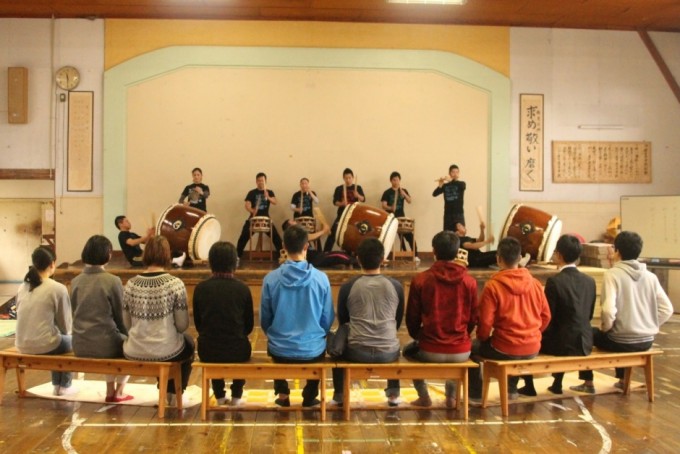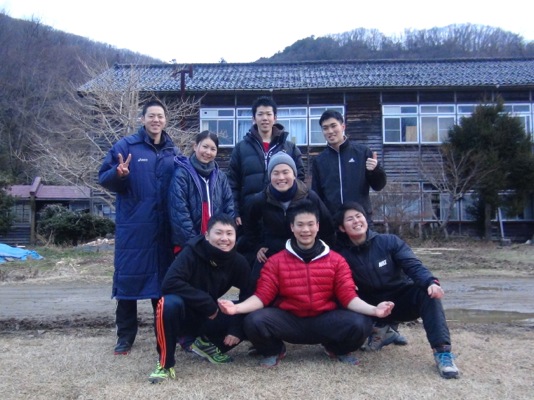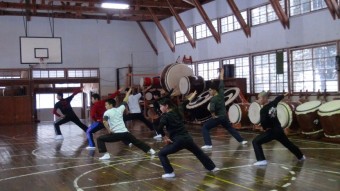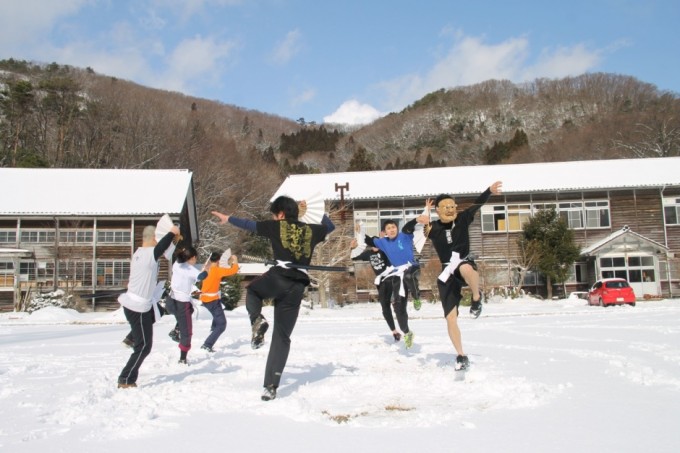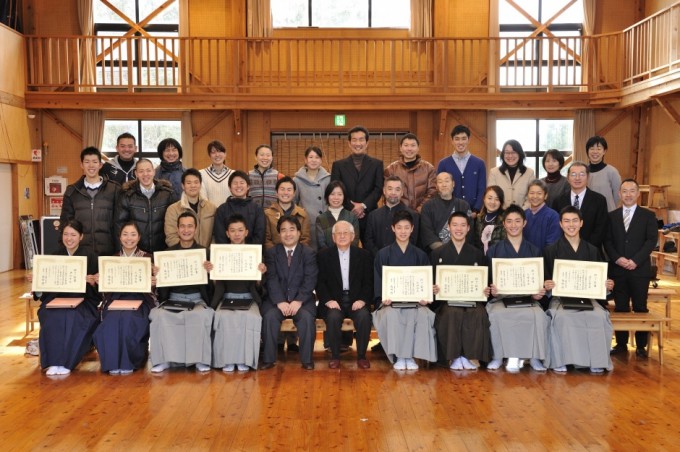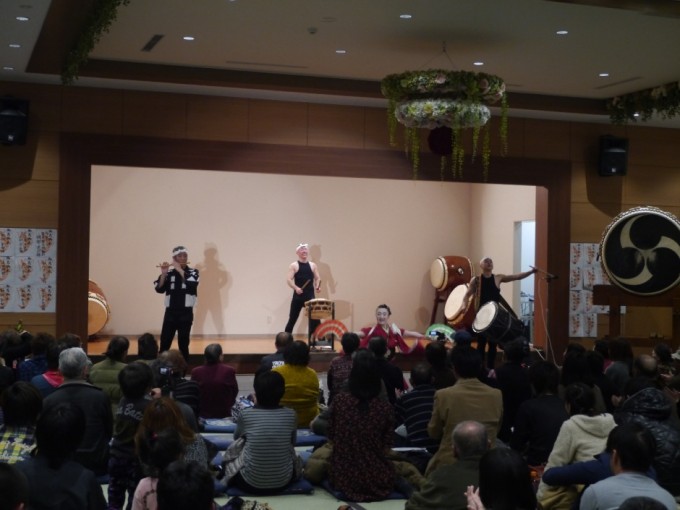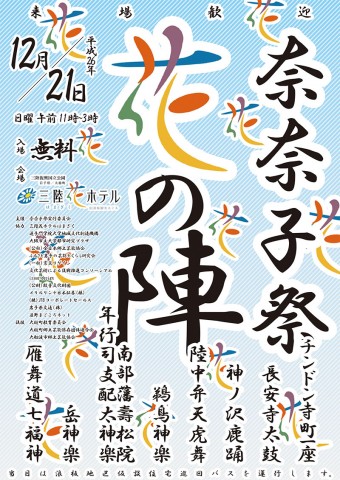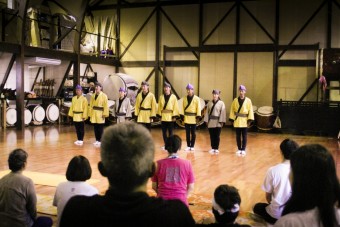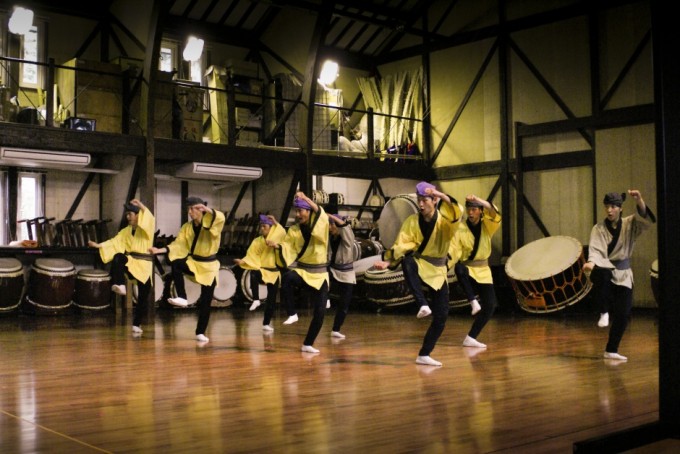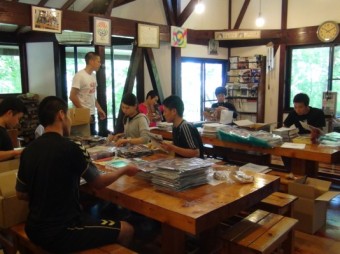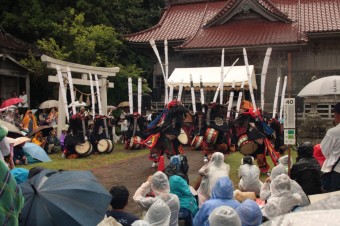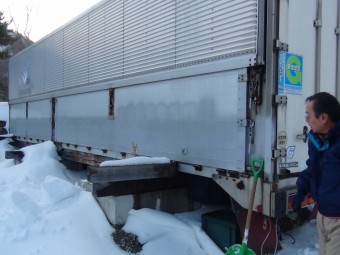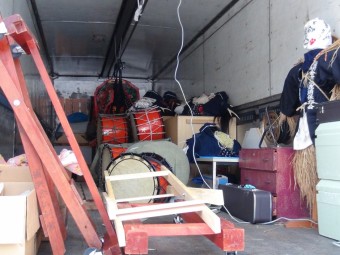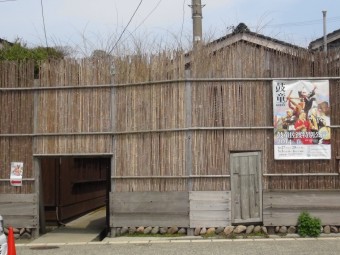Tag ‘Michiko Chida’
“Last Chance to Apply for ‘Kodo Juku 2016’!” by Michiko Chida
Last Chance to Apply for “Kodo Juku 2016”
This year we will hold Eiichi Saito’s annual live-in taiko workshop “Kodo Juku” from Oct. 7 (Fri) through 10 (Mon/Public Hol.) at the Kodo Apprentice Centre on Sado Island. Eiichi Saito took over the reigns to facilitate Kodo Juku in 1992 and back then we held Kodo Juku 4 times a year. For some time now, we have held it just once a year but one thing that has barely changed is the content. Each year the participants tell us how the simple taiko drum led them to find new connections between their own body and soul and helped them to create wonderful new bonds with people they had only just met at the workshop.
Everyone is welcome at Kodo Juku, whether you’ve played taiko before or not. First-timers will discover the special power of taiko and experienced players will discover many hints to playing taiko that truly moves people. The only condition is that you’ve never been to Eiichi Saito’s Kodo Juku before, as it is a once-in-a-lifetime workshop with no repeaters or groups of 2 or more.
The application deadline is July 30, so don’t delay! We look forward to receiving your application soon and welcoming you to Sado Island for Kodo Juku this autumn.
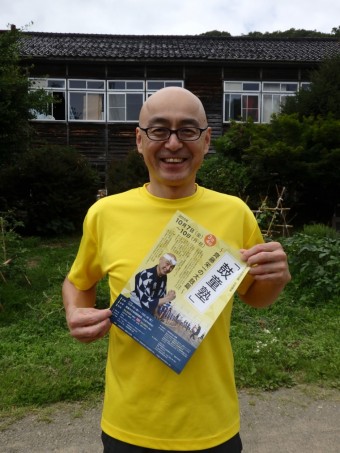
Eiichi Saito says “Join me for Kodo Juku on Sado Island!”
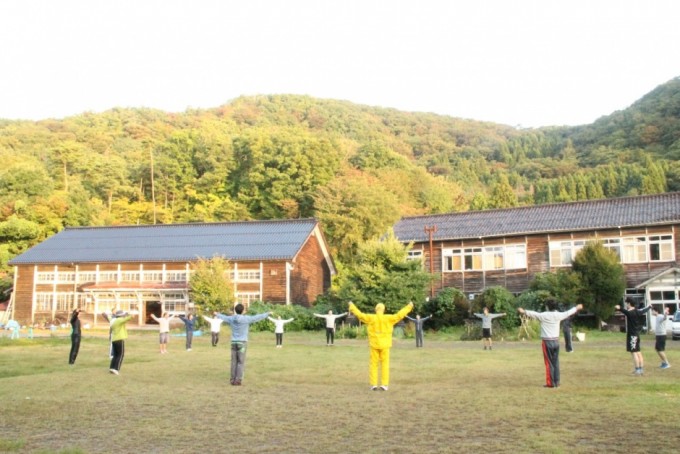
Early morning stretch time at Kodo Juku 2015
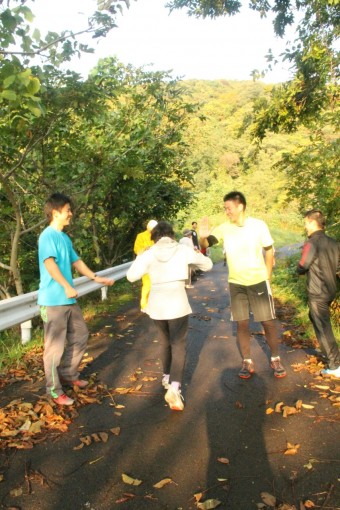
Jogging in the morning with the apprentices
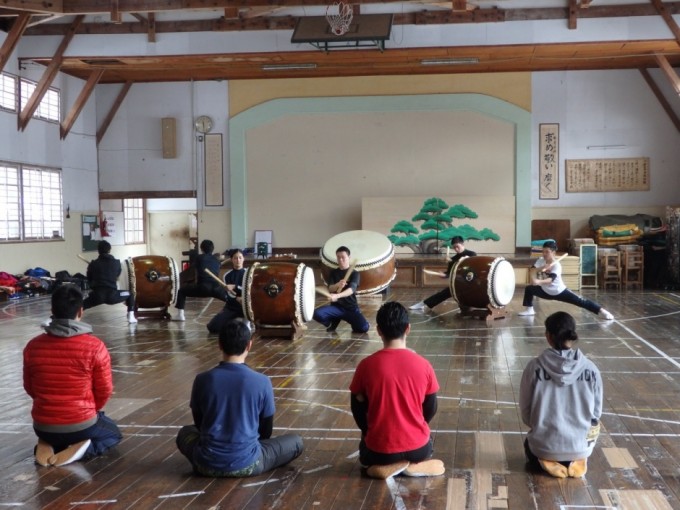
Workshops are held in the Kodo Apprentice Centre gym, where the apprentices spend two years training in hopes of one day performing on stage with Kodo.
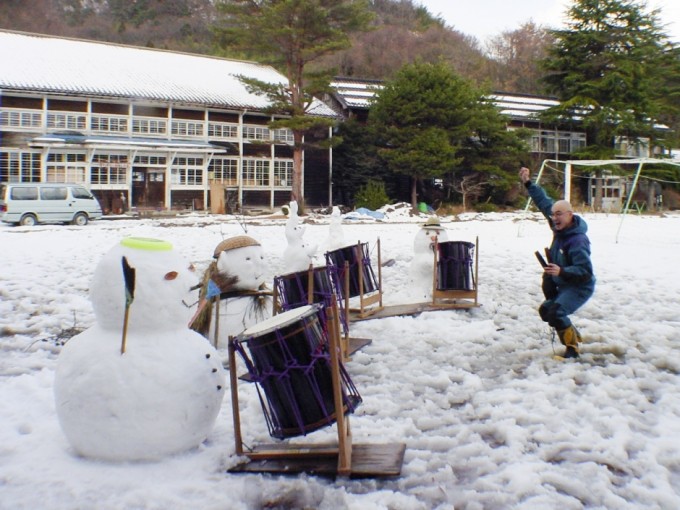
Preparations for each Kodo Juku begin 8 months prior with a lot of enthusiasm!
The second year apprentices act as staff during Kodo Juku each year, learning valuable skills as they host the participants. Eiichi and the apprentices can’t wait to welcome everyone to Kodo Juku this fall!
Kodo Juku: Eiichi Saito’s Taiko Workshop
Oct. 7 (Fri)–10 (Mon/Public Hol.), 2016 Kodo Apprentice Centre, Kakinoura, Sado Island, Niigata
Details for Kodo Juku 2016
http://www.kodo.or.jp/ws/juku_eiichi_en.html
“Kodo Apprentice Centre Welcomes the 35th Intake Class” by Michiko Chida
Apr. 9, 2016
Kodo Apprentice Centre Welcomes the 35th Intake Class
On Apr. 4, the new first-year apprentices arrived on Sado Island. This year we welcomed ten new apprentices from Japan (Niigata, Nagano, Tokyo, Kagawa, Okinawa), the USA, and Norway.
On their first day on Sado, each year our new apprentices meet at the bus stop in Kakinoura and walk the 1.2 km up the mountain road to the Apprentice Centre. As they climb the hill, step by step, they have time to think about their family and friends back home who sent them off with messages of support, and to think about their own reasons for coming here. From the next day, this route will be a slope that they run up on their daily training for the next two years.
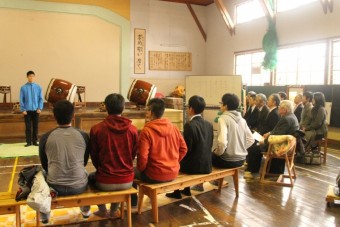
The new apprentices greet the members of Kodo, Kodo Cultural Foundation, president of Kitamaesen Co., Ltd., and their instructors at the Entrance Ceremony.
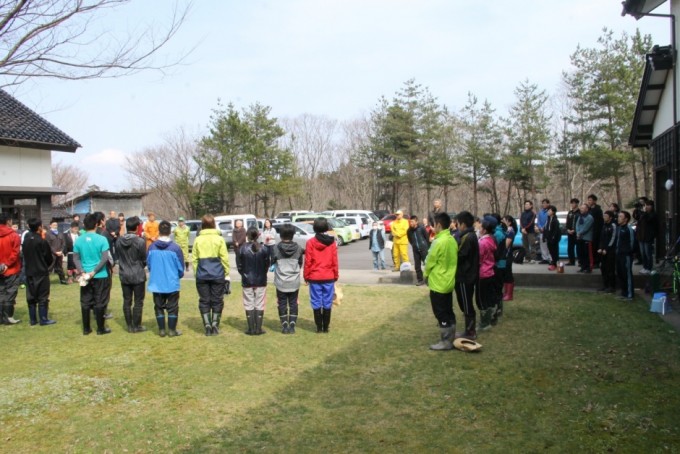
Two days later, the new apprentices all nervously introduced themselves to all the Kodo members and staff at Kodo Village. Then everyone got straight into a forest working bee together and the new apprentices all received warm words of welcome and encouragement from the whole Kodo group.
Today is their fifth day at the Centre and as they encounter new things everyday, I can already see they are off to a good start working as a team. I hope that each one of them keeps in mind all the people who are cheering them on as they strive towards their goals, and that they remember how happy they were to be selected to come here. I hope they will tackle their apprentice lifestyle with all their might and that each and every one of the new apprentices broadens their horizons and possibilities during the course of the year ahead.
Kodo Apprentice Centre
http://www.kodo.or.jp/apprentice/index_en.html
“The Year 33 (2014-2015) Apprentices Commence Their 2nd Year” by Michiko Chida
Feb. 21, 2015
Year 33 class of Kodo Apprentices finished their 1st year of our programme in January and started their 2nd year in February. They used to rely on the apprentices in the year above for all kinds of things, but those senior apprentices have left the nest, so now there are just eight of them living here: 7 males and 1 female. The number of apprentices has halved, so they have to cooperate more than ever and figure out how to live together comfortably, as a new team. Otherwise, they will not be able to concentrate on their studies nor improve as a class.
On top of those changes, a powerful, relentless cold wave hit Sado during their transition period. It was the first winter on Sado for the new 2nd year apprentices, so they looked nervous to find out just how cold it would get. One night, when it was forecast to reach a low of -4℃ , one of the apprentices anxiously asked me:
“Is is going to get even colder?”
I said, “No, no, this is the coldest it gets on Sado. It won’t get any colder than this, so you can wear your warmest clothes now. You’ll be all right, you will survive!”
They had a dance practice day on one of those freezing cold days in February.
While teaching them Ohara-bushi, a Tsugaru dance from Aomori Prefecture in Northern Honshuu, Chieko Kojima looked outside and happily exclaimed, “Perfect! It really looks like Aomori!”
Yasuhiko Ishihara, the head of the Apprentice Centre, teaches them demon sword dance Onikenbai, which is a traditional performing art from Iwate Prefecture, also located in northern Japan. He told them, “The locals practice this dance outside at this time of year…”
The Year 33 apprentices must have become both physically and mentally stronger since last year…
I hope they will have grown even more by the time the new 1st year apprentices join them in April.
“Year 32 (2013-2014) Apprentice Graduation Ceremony” by Michiko Chida
Year 32 (2013-2014) Apprentice Graduation Ceremony (Jan. 17, 2015)
Eight members from the Year 32 (2013-2014) class graduated from the Kodo Apprentice Centre on January 17, 2015, having completed our 22-month-long apprentice programme.
When they entered the programme, there were 12 apprentices in their class, but 5 of them left after a year and the remaining 7 members advanced to the second year of the programme. In June 2014, an apprentice from the year above them, who took time off due to an injury, returned to continue his studies. The eight of them, with unique personalities that inspired each other, worked diligently to grow as individuals.
On this final day, they expressed their gratitude for all of the encounters & experiences made possible by their time at the Apprentice Centre. They ended their apprentice life with one last performance together, as a team, showing us their sense of unity.
Now, they will set off on different paths, but I hope that what they experienced here will become a foundation, source of confidence, and something that they will treasure for the rest of their lives.
Thank you very much to all of you who loved and encouraged these young apprentices over the past two years.
“This Year’s Wonderful ‘Nanako Matsuri'” by Michiko Chida
“Nanako Matsuri” This Year in Otsuchi, Iwate
Photo from Dec. 2013 “Nanako Matsuri – Fuyu no Jin”
(Courtesy of Kazuhiro Nishijima, Minzoku Geino STREAM )
In December last year, a small Kodo cast took part in a special festival, “Nanako Matsuri.” I remember this “homemade” festival vividly: the wonderful local performing arts from Tohoku’s coastal regions, the passion of the performers, and the enthusiasm of the locals who wholeheartedly looked forward to seeing them. This festival cleansed my soul and gave me a lovely sense of peace.
This year’s festival, “Nanako Matsuri – Hana no Jin” will be held at Sanriku Hana Hotel Hamagiku, Otsuchi, Iwate on December 21 (Sun) from 11:00 am. It will be packed with wonderful performances, but Kodo will not appear this time! We hope you can go along all the same!
“Nanako Matsuri” Concert Flier (in Japanese)
The Tohoku area is a vast treasure trove of traditional performing arts.
This festival is planned and presented by Nanako & Masayuki Sasayama, whose home is a performance venue for the local kagura (sacred Shinto dance & music), and folk art professor Hiroyuki Hashimoto. They believe that the folk performing arts in everyone’s hearts will lead the way to the area’s recovery from this natural disaster.
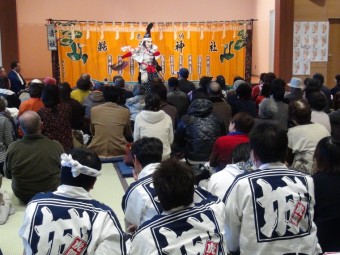
“Nanako Matsuri” is a great festival because you can see an array of performances and it gives you the chance to meet and talk to the members of the various performance groups who uphold their local traditional arts. This year, the day before the festival has been set aside for exchange, so come along on Dec. 20th to interact with the locals.
Just by going to the disaster area, meeting people there, and watching their performing arts, it really cheers the locals on and supports the area’s recovery. We hope you will show your interest and support by going along to “Nanako Matsuri” this year.
Please note that Kodo will not appear at this year’s festival.
◆JTB Tour (in Japanese)
http://www.jtb.co.jp/tabeat/List.asp?Tourno=c94931bd7ced4f1db82e4af5
Kodo Website | Heartbeat Project

“Fundraising for Urahama Folk Performing Arts Center” by Michiko Chida
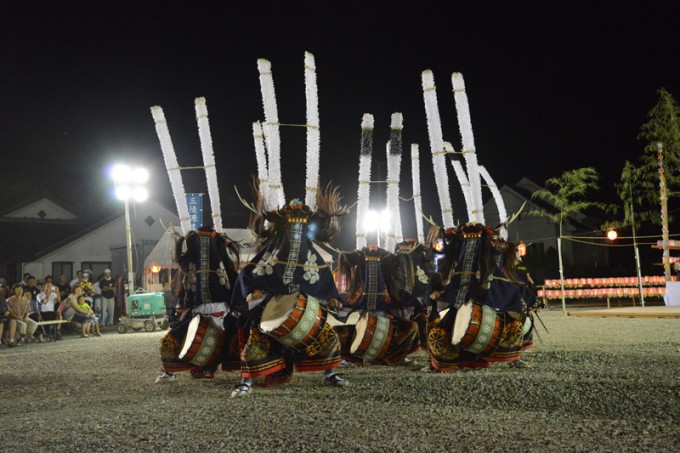
Sorry for this late announcement.
Kodo set up collection boxes in the exhibition corner at Asakusa Public Hall during the “Mystery” performances in July. The total of the donations collected was 10,406 yen.
We sent the donations to Urahama Nenbutsu Kenbai & Kanatsu-ryu Yanagawa Shishi Odori, telling them that it was from Kodo’s audience. Thank you very much to everyone who generously donated to this cause.
We would appreciate it if you would tell your friends about this project, too.
Kodo is still collecting donations for this project via a collection box at the Sado Island Taiko Centre (Tatakokan). If you visit the Centre, please bring some coins or notes and show your support!
YouTube▶http://youtu.be/mjzANRusHKo
In the video above, you can see how the area looked in 2011 after the Tohoku Pacific Earthquake.
It talks about what they lost, and why they needed to keep their traditions alive, especially at a time when life became difficult and everyone faced so many obstacles.
YouTube▶http://youtu.be/e_CxP-LjeLs
This video is from March 2014, three years on from the Tohoku Pacific Earthquake. It shows Shishiodori and Kenbai, which were performed to pray for the lives lost in the disaster. And you can see the local children who are the future of this area. This building will help uphold the traditional performing arts of this area, so they will be passed down to future generations. It will also be a place for exchange, bringing together people connected by the natural disaster.
We really appreciate your support and generosity.
About Fundraising for Urahama Folk Performing Arts Center (in Japanese)
Kodo Website | Heartbeat Project
“Kodo Apprentice Recital: Okinawan Dance ‘Muribushi'” by Michiko Chida
Aug. 1, 2014
Kodo Apprentice Recital: Okinawan Dance Muribushi
The 2nd year apprentices spent one month learning Okinawan dance Muribushi, during this hot summer season. Today, they performed it for all the Kodo members and staff.
Okinawan dance expert Mitsue Kinjo has been teaching our apprentices for the last twenty years. By learning this unique, traditional Okinawan dance style, the apprentices are taught a fundamental attitude towards learning things. This is a timeless lesson.
“When you aim to create something new, first you have to take something in and absorb it within yourself. Then, something will be created from that. A new creation will come from something that takes root inside you and breathes. It is not something that you try to show or make decorative.”
Mitsue works hard with apprentices, actually, even harder than the apprentices, using her body and voice to passionately show and convey to them the importance of creating your own core.
I am sure that when the Kodo members, and the staff who were formerly apprentices, watch this annual recital that are reminded of their own time practicing as apprentices, frantically trying to use their bodies and minds well.
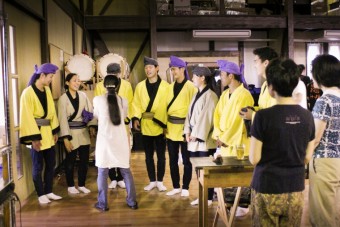
So, how were they today?
“Your hearts were all together, as one. You really did your best.”
After gruelling practices, Mitsue’s warm words echoed in the apprentices’ hearts. No one was selfish at all, and as individuals they all pulled together to perform together, which created such great power. Maybe today they understood the true meaning of Muribushi at last, which translates as “a group of stars.”
“Sending Out Kodo’s Monthly Newsletter” by Michiko Chida
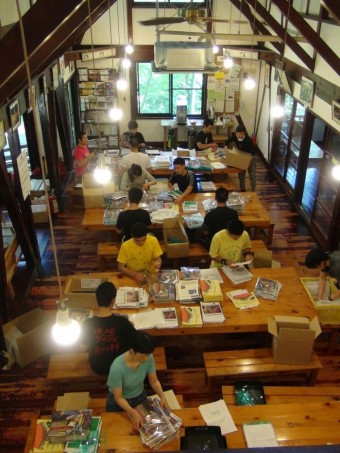
On the 10th of every month, the dining room at Kodo Village turns into a workspace as we prepare to send out the latest Monthly Japanese Newsletter “Kodo” to Kodo no Kai (Japanese Friends of Kodo service) members. The 1st-year Kodo apprentices always do this task, and this year they are joined by the new “Community Development Course” trainees. The envelopes are prepared by Kodo staff members and the apprentices insert the newsletter and flyers, seal them, count them for each region, and carry them to the front door to be picked up for shipping.
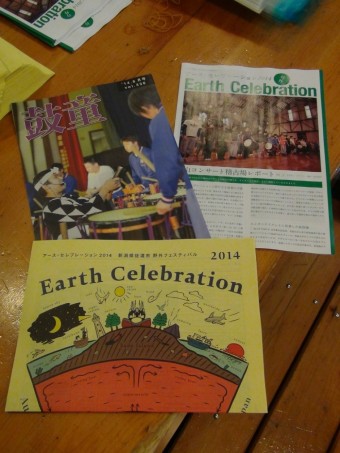
This month, we have sent out these 3 items. On the front page of the newsletter, you can see Kenta Nakagome leading a workshop during a “School Workshop Performance.” There are two other pamphlets: the Earth Celebration 2014 Programme and information about the guests for this year’s Shiroyama Concerts.
“Asakusa Performances: Collecting Donations for a New Folk Performing Arts Center” by Michiko Chida
From June 21-25, during the “Kodo One Earth Tour 2014: Mystery” Asakusa performances, we are asking people to help raise funds to build the Urahama Folk Performing Arts Center (Urahama Minzoku Geino Denshokan).
About Fundraising for Urahama Folk Performing Arts Center (in Japanese)
Please donate to the Urahama Folk Performing Arts Center Construction Fund and help build a new base for the folk arts in an area affected by the Tohoku Pacific Earthquake.
Urahama Nenbutsu Kenbai (sword dance) and Urahama Shishi Odori (deer dance), two traditional performing arts upheld in the Okirai area of Sanriku in Ofunato City, were seriously affected by the damaging 2011 Tohoku Pacific Earthquake. The equipment for Shishi Odori barely remained, but all the equipment and the base for Nenbutsu Kenbai was lost. Even though they have kept their spirits up, it must have been hard for the people there to see a way forward through this dark situation these past three years.
Urahama Shishi Odori with Kanatsu-ryu Yanagawa Shishi Odori at the Earth Celebration 2008
Last January, the people of Urahama decided to build a folk performing arts center as a base for their traditional performing arts. This facility is their pledge to hand the wonderful regional folk arts, which cultivate their area, down to future generations: it is their vow to not be beaten by the disaster. They have great confidence in the power of traditional folk arts and they are working hard and enthusiastically, encouraging people involved with folk arts in other areas to follow their lead.
Their base was washed away by the tsunami, so they had to keep their equipment in a storage container next to the leader’s house. (Photo from Feb. 2014)
One of the reasons why Kodo wants to help them is that Urahama Shishi Odori is a part of Kanatsuryu Yanagawa Shishi Odori, who have been teaching Shishi Odori to Kodo since 1980. We have the same masters and same dance style, so we are like brothers. Actually, in 2008 some of the Urahama Shishi Odori members joined Kanatsuryu Yanagawa Shishi Odori to perform at our festival on Sado Island, “Earth Celebration.”
All the equipment is currently kept in an unsuitable environment. The new building needs to be built as soon as possible.
The Center will be built using personal funds and grants, and also requires 10,000,000 yen in donations to make up the remainder. From January to May, they collected more than half of this amount, but they still need 3,000,000 yen to reach their goal. They are almost there!
The basic amount they are requesting for bank donations is 10,000 yen or more. By donating this amount, your name will be displayed in the Center when it is completed. Kodo has put collection boxes in the exhibition corner at Asakusa Public Hall during the “Mystery” performances, which welcome donations large or small. Thank you in advance for your kind support.
Under the Heartbeat Project, Kodo is supporting the fundraising campaign to build the Urahama Folk Performing Arts Center. We would really appreciate your support and generosity.
“Shukunegi, the Venue for ‘Kodo Special Performances on Sado Island’” by Michiko Chida
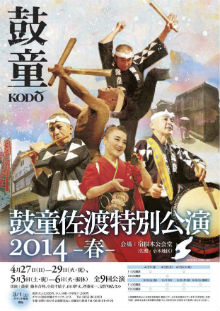 “Kodo Special Performances on Sado Island 2014 – Spring” started on April 27th. Right from the opening performance, we have welcomed so many audience members from around Sado Island and from offshore. Thank you very much for coming!
“Kodo Special Performances on Sado Island 2014 – Spring” started on April 27th. Right from the opening performance, we have welcomed so many audience members from around Sado Island and from offshore. Thank you very much for coming!
These performances are being held in Shukunegi. This village has a wonderful atmosphere, so I would like to introduce it further to you.
Shukunegi flourished in the Edo era due to trade by sengoku-bune (large junks/wooden sailing ships) and there about 100 houses in the village, nestled in this small valley. Many of the houses were constructed by shipbuilders and built using their own special techniques to suit the small plots of land. The exteriors are very simple, but the interiors are gorgeous. Some of the houses even feature beautifully laquered pillars, ceilings and beams on the interior.
There is a bamboo fence at the entrance to the village. Stones and three horizontal wooden boards are stacked up at the bottom of it. The bamboo fencing behind is so long and thin. We are allowed to put our poster on this beautiful structure only during this performance period. When you walk through the central gate, it feels like you have wandered into another world.




